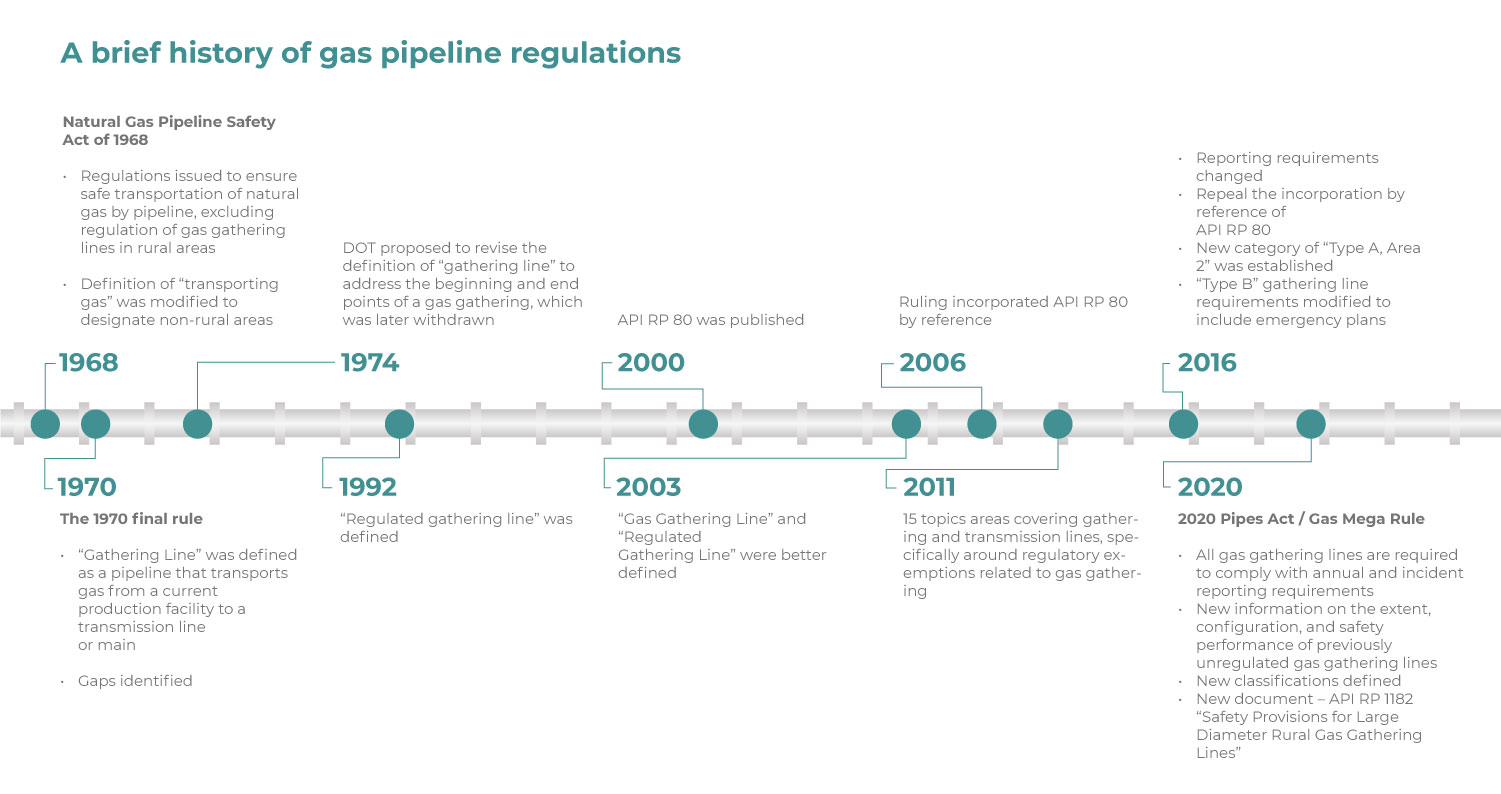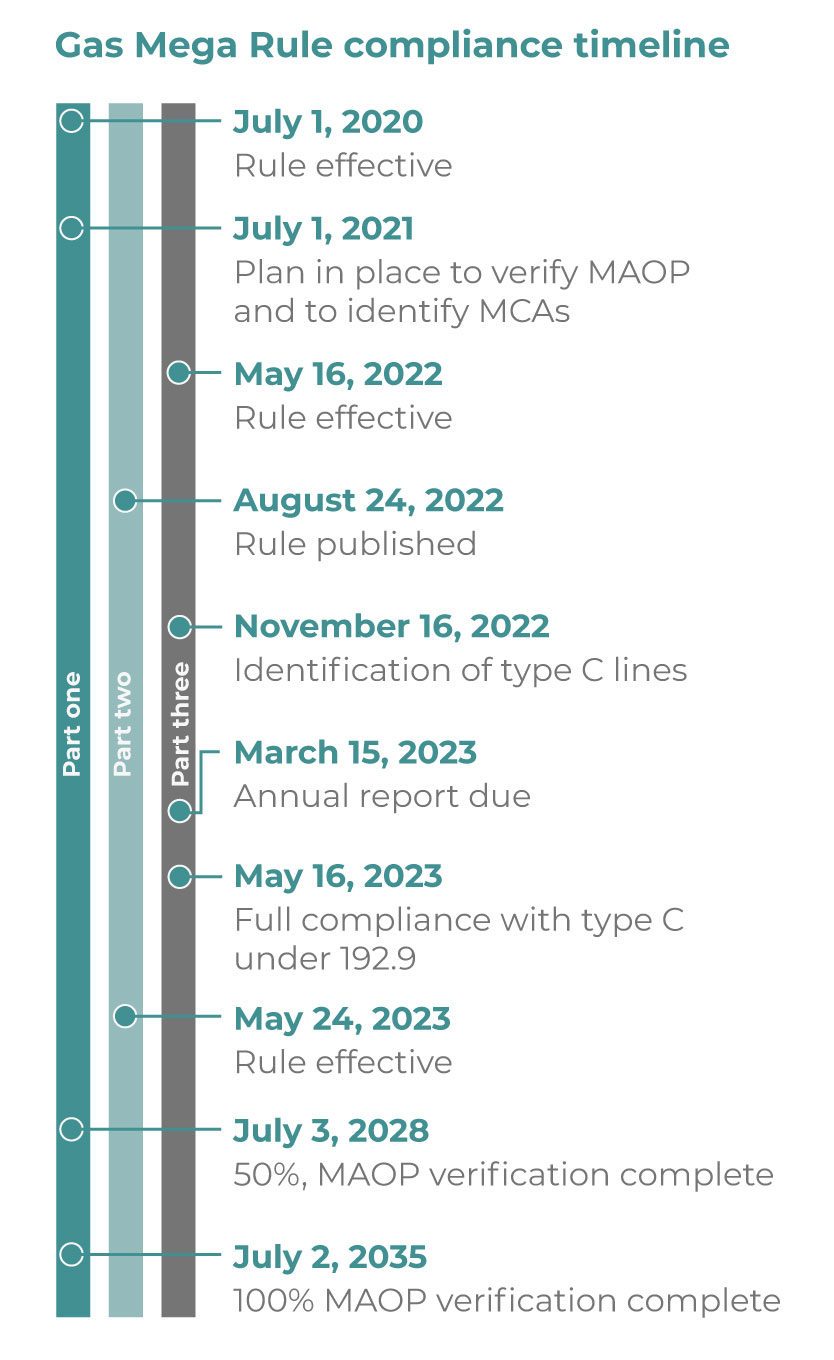April 2023, Vol. 250, No. 4
Features
PHMSA Update: Leak Detection Rules Point to Value of Regulation Compliance Service
By Carin Meyer, Regulation Compliance Program Specialist, Atmos International
(P&GJ) — To be able to operate within their regions, the onus is on pipeline operators to abide by leak detection and incident response rules. Federal regulators like the Pipeline and Hazardous Materials Safety Administration (PHMSA) regularly implement new standards as part of their renewed focus on leak detection for natural gas and hazardous liquid pipelines to ensure the people, public and environment are kept safe.
It’s important to stay current on the rules, regulations, guidance and laws for a pipeline network, especially when new and time-sensitive rulings come in which require actioning quickly. This article uses the introduction of three time-sensitive rulings with impending deadlines as examples to highlight the importance of a pipeline regulation compliance service: the Gas Mega Rule, the Safety of gas transmission pipelines regulation and the valve installation and minimum rupture detection standards.
- Gas Mega Rule
Since the mid to late 20th century, a range of rulings have been introduced to ensure safe and compliant gas pipeline operations and they have all led up to some of the time-sensitive deadlines seen in the Gas Mega Rule today.
The natural gas pipeline safety act of 1968 started by ensuring the safe transportation of natural gas by pipelines. This was followed by the 1970 final rule which defined a “gathering line” as a pipeline that transports gas from a current production facility to a transmission line or main, with “regulated gathering line” receiving its own definition in 1992.
From the 2000s, API RP 80 was published which provided a definition of onshore gas gathering pipelines and this definition was improved throughout time. In 2020, the Gas Mega Rule, along with the PIPES Act of 2020, was introduced.
From July 2020, operators had to begin retaining records for each individual welder qualification at the time of construction for a minimum of five years following construction, per § 192.227. For transmission pipe installed after July 1, 2021, operators must begin retaining records for each person’s plastic pipe joining qualifications at the time of construction for a minimum of 5 years following construction, per § 192.285.
If subject to § 192.624, operators must develop and document procedures for completing all actions required by this section (see FAQ-12 regarding moderate consequence area identification2). These procedures must include:
- A process for reconfirming maximum allowable operating pressure (MAOP) for any pipelines that meet a condition of § 192.624(a)
- A process for performing a spike test or material verification per §§ 192.506 and 192.607, if applicable
- A process for performing an engineering critical assessment (ECA) for MAOP reconfirmation per § 192.632, if implemented
Operators must modify their launchers and receivers that will be used after this date to meet the conditions of §192.750.
Three deadlines related to the Gas Mega Rule come into effect this year (2023), the first being that 2022 annual reports from Part 3 of the ruling are due in March. Part 3 of the ruling places an emphasis on data gathering to direct future regulations and will require over 400,000 gathering lines to file annual reports.
The next deadline relates to pipelines categorized as Type C under 192.9. Pipelines in this group are Type A regulated gas gathering lines in a Class 1 location that have a nominal diameter of 8.625 inches or greater and are metallic with an MAOP that produces a hoop stress of 20% or more of specified minimum yield strength (SMYS) or, if the stress level is unknown, the MAOP is more than 125 psig.3 Pipelines in type C need to be fully compliant with Part 3 of the Gas Mega Rule by May 16, 2023.
Finally, Part 2 of the Gas Mega Rule is effective from May 24, 2023, and will require pipeline inspection after extreme weather events, AC and DC interference surveys, DCVG and ACDV after line backfill, an internal corrosion program and management of change.
- Gas Gathering Breakdown
Amendments to the Safety of Gas Gathering Pipelines Regulation were published on Aug. 24, 2022, and will be effective from May 24, 2023. The aims of these amendments have the following objectives:
- Clarify certain integrity management provisions
- Codify a management of change process
- Update and bolster gas transmission pipeline corrosion control requirements
- Require operators to inspect pipelines following extreme weather events
- Strengthen integrity management assessment requirements
- Adjust the repair criteria for high consequence areas
- Create new repair criteria for non-high consequence areas
- Revise or create specific definitions related to the above amendments
While PHMSA will be exercising its inherent enforcement discretion in the nine months following the official date this ruling comes into effect from May 24, 2023, to Feb. 24 2024,4 this only applies to operators of existing onshore gas transmission pipelines in service. For any operators whose pipeline networks don’t fit these criteria, there is a limited timeframe to fulfil these obligations before penalties are incurred from PHMSA.
- Valve Installation Standards
In response to congressional mandates and incorporated recommendations from the National Transportation Safety Board, these proposals are necessary to reduce the consequences of large-volume, uncontrolled releases of natural gas and hazardous liquid pipeline ruptures after a number of reported incidents caused significant damage to the environment or human life.5
The standards apply to most Type A gas gathering and gas transmission lines (with limited exceptions, such as if the pipeline segment is in a Class 1 or Class 2 location and has a potential impact radius less than or equal to 150 feet).6
The standards also apply to hazardous liquid pipelines and include a small subset of rural gathering lines which cross bodies of water greater than 100 feet wide. The aim of the rule is to establish minimum safety performance standards for the identification of ruptures, pipeline segment isolation and other mitigative actions for pipelines on which rupture mitigation valves (RMVs) or alternate technology are installed.
The ruling was published on April 8, 2022, and became effective from Oct. 5, 2022. Although it is possible to request an extension of the compliance deadline based on financial, operational or technical difficulty, this is on a discretionary basis and PHMSA will require the deadline to be met eventually.7
The responsibility will always be on pipeline operators to ensure they demonstrate compliance and meet deadlines. However, sometimes time-sensitive rulings come in like the Gas Mega Rule, the Safety of Gas Gathering Pipelines regulation or the Valve Installation and Minimum Rupture standards with seemingly unachievable deadlines.
Gathering Pipes Now Regulated in Pennsylvania
The Pennsylvania Public Utility Commission (PUC) held a hearing in December to explain new regulations based on directives from the federal Pipeline and Hazardous Materials Safety Administration (PHMSA) to begin regulating previously unregulated natural gas gathering pipelines in the Keystone State.
Pennsylvania is a “certified state” in the federal PHMSA pipeline safety program. In essence, PHMSA delegates its authority to the PA PUC, to act on its behalf, with respect to pipeline safety. The PHMSA recently changed federal regulations that empower the agency to regulate gathering pipelines.
In the updated federal regulations, PHMSA defines two new categories of pipelines: Type C and Type R. It is Type R, which are pipelines with a diameter of less than 8.625 inches and with very low pressure, which has become a bone of contention with PA producers.
The Pennsylvania Independent Oil & Gas Association (PIOGA) filed a petition with the PUC asking the commission to reconsider its claim that it has the right to regulate Type R gathering pipes. Such pipelines are not dangerous in the least. They don’t explode.
Yet the PUC says such pipelines must now be regulated under PHMSA regulations. PIOGA has said if the PUC does not relent on regulating Type R pipelines, the group will “consider other options” to resolve the dispute.
DOT Awarding $75.6 Million for Pipeline Safety, Oversight
The U.S. Department of Transportation’s Pipeline and Hazardous Materials Safety Administration (PHMSA) is granting $75.6 million to fund projects and activities to improve the safety of pipelines.
The grants will support the jobs of state pipeline inspectors, important pipeline safety training and educational programs, and the advancement of pipeline safety technologies. Recipients include state pipeline safety programs, state One-Call and damage prevention centers, community and non-profit organizations, as well as six universities.
“These grants aim to provide states and communities with the resources they need to address the pipeline safety challenges today and to develop solutions to the challenges of tomorrow,” said PHMSA Deputy Administrator Tristan Brown. “With U.S. production and exports at record levels, pipelines are continuing to operate at high capacity, underscoring the critical need to continue our investments in advancing pipeline safety and supporting communities with the resources they need.”
Of the recent awards, $64.9 million went to state pipeline safety programs to reimburse states for a portion of their operating costs for inspecting intrastate pipelines and underground natural gas storage facilities, as well as to enforce safety regulations within state boundaries.
State pipeline safety programs employ about 435 full-time inspectors that help oversee over 90% of America’s regulated natural gas and hazardous liquid pipeline network.
As part of its Competitive Academic Agreement Program (CAAP), PHMSA awarded $4.8 million to five collegiate institutions in North Dakota, Rhode Island, Texas, Ohio and Oklahoma.
The CAAP grants will support research aimed at improving the safety of carbon dioxide, hydrogen and particularly older, higher risk pipelines by improving pipeline coatings and advancing our understanding of risks associated with geographic proximities to pipeline incidents.
Other grants issued today include the following, which among other things help mitigate threats from excavation related incidents:
- $2.2 million in Technical Assistance Grants
- $1.7 million in State Damage Prevention Program Grants
- $1.1 million in One-Call Grants
- $1.03 million in Pipeline Emergency Response Grants
References:
1 https://www.aiworldwide.com/wp-content/uploads/2023/01/MegaRule-Rocky-Mountain-Presentation-BGM.pdf
5 https://www.phmsa.dot.gov/regulations/federal-register-documents/2022-07133
6 2022-07133.pdf (govinfo.gov)
7 https://www.govinfo.gov/content/pkg/FR-2022-04-08/pdf/2022-07133.pdf
Author: Carin Meyer, a regulatory specialist at Atmos International, helps North American customers overcome significant challenges in the interpretation of pipeline compliance regulations and supports them in becoming leak detection compliant.







Comments